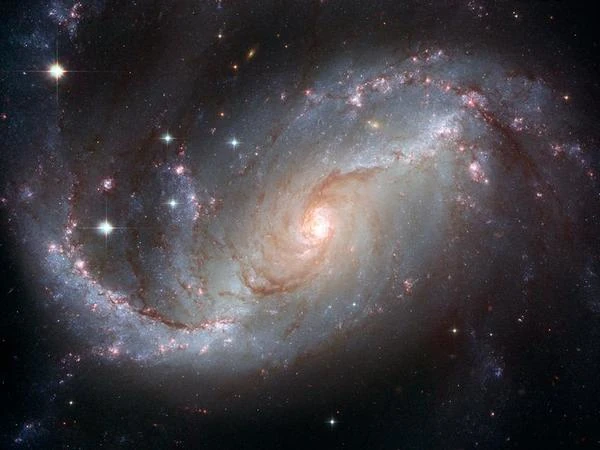
The NGC 1672 is a galaxy located in the constellation Dorado, about 60 million light-years away. Its main feature is its galactic bar, which fuels its nucleus and influences the dynamics of its spiral arms. The arms show a logarithmic spiral structure, typical of barred spiral galaxies, where the density of gas and stars varies according to a density wave.
The spiral arms of NGC 1672 are particularly active in terms of star formation. Observations in visible and infrared light show extensive HII regions, where massive O and B stars ionize the surrounding gas. These areas correspond to concentrations of molecular gas detected by CO emissions.
The dynamics of the arms are strongly influenced by the central bar, which acts as a mechanism for transporting matter to the center, increasing the density of gases and promoting star formation on the periphery of the nucleus. Numerical simulations show that the arms can be reinforced by density waves, which create a quasi-stable spiral pattern over hundreds of millions of years.
The active nucleus of NGC 1672 emits strongly in X-rays, ultraviolet, and infrared. This activity results from the accretion of matter onto the central black hole, whose mass is estimated at \(\sim 10^7\ M_\odot\). The energy released by accretion heats the accretion disk and produces jets and galactic winds that can regulate star formation around the nucleus.
Spectroscopic observations reveal broad emission lines, characteristic of a Seyfert type 2. This classification indicates that the nucleus is obscured by a torus of dust and gas, but remains observable thanks to its X-ray and infrared emissions. The central bar helps feed the nucleus with matter, establishing a direct link between galactic morphology and central activity.
Observing NGC 1672 in visible, infrared, and X-ray light allows mapping both stars, gas, and dust. This approach reveals areas of intense activity in the bar and spiral arms.
N.B.:
Measuring the rotational speed of NGC 1672 allows estimating the total mass of the galaxy using the relation \(v^2 = G M / r\), where \(v\) is the orbital speed, \(r\) the radius, and \(M\) the total enclosed mass.
| Characteristic | Value | Unit | Comment |
|---|---|---|---|
| Morphological type | SB(r)b | Barred spiral galaxy with partial ring | |
| Distance | 60 | Mly | Estimated from spectral shift measurements |
| Mass of the central black hole | 107 | M☉ | Comparable to black holes in other barred spirals |
| Galactic diameter | 85 | kpc | Measured from edge to opposite arm |
Source: NASA/IPAC Extragalactic Database (NED), ESO – European Southern Observatory.
The NGC 1672 illustrates the typical evolution of a barred spiral galaxy. Its central bar, probably formed by gravitational instabilities in the stellar disk, acts as an engine for matter redistribution, feeding the active nucleus and modulating star formation along the spiral arms.
The spiral arms, structured by density waves, are the site of intense stellar activity, while the central nucleus remains active due to gas accretion. Gravitational interactions, even weak ones, with the environment can slightly disrupt this dynamic, but the overall morphology remains stable over hundreds of millions of years.
In the long term, the evolution of NGC 1672 depends on the balance between gas replenishment, nuclear activity, and matter consumption by star formation. This cycle illustrates the close link between morphological structure, internal dynamics, and galactic evolution in barred spirals.
N.B.:
This synthesis is based on multi-wavelength observations and numerical simulations that model bar formation, gas redistribution, and stellar evolution.